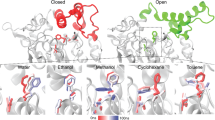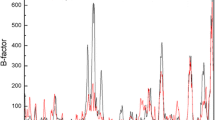Abstract
The discovery or development of thermoalkalophilic lipases that show high levels of catalytic activity in organic solvents would have important industrial ramifications. However, this goal is yet to be achieved because organic solvents induce structural changes in lipases that suppress their catalytic abilities. A deep understanding of these structural changes to lipases in the presence of organic solvents is required before strategies can be devised to stop them from occurring. In this work, we investigated the effects of an organic reaction medium, toluene, on the structure of the Bacillus thermocatenulatus lipase BTL2 using MD simulation. The main aims were to identify the regions of the protein that are particularly sensitive to the presence of an organic solvent, and how the presence of a hydrophobic medium affects the overall stability of the enzyme. Upon analyzing how the behavior of the enzyme differed in aqueous and hydrophobic media, it was found that many significant zones of the protein suffer in the presence of an organic solvent, which increases the rigidity of the system. This was readily apparent when we investigated important noncovalent interactions (salt bridges) and probed how distances between the atoms of the catalytic triad Ser114, Asp318, and His359 change in the presence of toluene. Moreover, the high tendency for the system to destabilize in toluene was explained by the results of FoldX calculations. Calculations showed that the addition of a small amount of water to the hydrophobic reaction environment should restore the required flexibility of BTL2. The insights gained from the analysis of our simulations allowed us to propose a modification of BTL2, the G116P mutation, that should result in the structural behavior of BTL2 in organic solvent being closer to that of BTL2 in water.









Similar content being viewed by others
References
Gurung N, Ray S, Bose S, Rai V (2013) A broader view: microbial enzymes and their relevance in industries, medicine, and beyond. Biomed Res Int 2013:329121. https://doi.org/10.1155/2013/329121
Park H, Lee K, Chi Y, Jeong S (2005) Effects of methanol on the catalytic properties of porcine pancreatic lipase. J Microbiol Biotechnol 15(2):296–301
Gupta R, Gupta N, Rathi P (2004) Bacterial lipases: an overview of production, purification and biochemical properties. Appl Microbiol Biotechnol 64(6):763–781. https://doi.org/10.1007/s00253-004-1568-8
Grbavcic SZ, Dimitrijevic-Brankovic SI, Bezbradica DI, Siler-Marinkovic SS, Knezevic ZD (2007) Effect of fermentation condition on lipase production by Candida utilis. J Serb Chem Soc 72(8-9):757–765
Klibanov AM (1997) Why are enzymes less active in organic solvents than in water? Trends Biotechnol 15(3):97–101. https://doi.org/10.1016/S0167-7799(97)01013-5
Gutman AL, Meyer E, Kalerin E, Polyak F, Sterling J (1992) Enzymatic resolution of racemic amines in a continuous reactor in organic solvents. Biotechnol Bioeng 40(7):760–767. https://doi.org/10.1002/bit.260400703
Schmidt-Dannert C, Rua ML, Atomi H, Schmid RD (1996) Thermoalkalophilic lipase of Bacillus thermocatenulatus. I. Molecular cloning, nucleotide sequence, purification and some properties. Biochim Biophys Acta 1301(1-2):105–114
Dodson G, Verma CS (2006) Protein flexibility: its role in structure and mechanism revealed by molecular simulations. Cell Mol Life Sci 63(2):207–219. https://doi.org/10.1007/s00018-005-5236-7
Kumar A, Dhar K, Kanwar SS, Arora PK (2016) Lipase catalysis in organic solvents: advantages and applications. Biol Proced Online 18:2. https://doi.org/10.1186/s12575-016-0033-2
Herbert RA (1992) A perspective on the biotechnological potential of extremophiles. Trends Biotechnol 10(11):395–402
Jaeger KE, Ransac S, Dijkstra BW, Colson C, van Heuvel M, Misset O (1994) Bacterial lipases. FEMS Microbiol Rev 15(1):29–63
Riberio DB, de Castro AM, Coelho MAZ, Freiere DMG (2011) Production and use of lipases in bioenergy: a review from the feedstocks to the biodiesel production. Enzym Res 615803. https://doi.org/10.4061/2011/615803
Jeong ST, Kim HK, Kim SJ, Chi SW, Pan JG, Oh TK, Ryu SE (2002) Novel zinc-binding center and a temperature switch in the Bacillus stearothermophilus L1 lipase. J Biol Chem 277(19):17041–17047. https://doi.org/10.1074/jbc.M200640200
Carrasco-Lopez C, Godoy C, de Las Rivas B, Fernandez-Lorente G, Palomo JM, Guisan JM, Fernandez-Lafuente R, Martinez-Ripoll M, Hermoso JA (2009) Activation of bacterial thermoalkalophilic lipases is spurred by dramatic structural rearrangements. J Biol Chem 284(7):4365–4372. https://doi.org/10.1074/jbc.M808268200
Trodler P, Pleiss J (2008) Modeling structure and flexibility of Candida antarctica lipase B in organic solvents. BMC Struct Biol 8:9. https://doi.org/10.1186/1472-6807-8-9
Tejo BA, Salleh AB, Pleiss J (2004) Structure and dynamics of Candida rugosa lipase: the role of organic solvent. J Mol Model 10(5-6):358–366. https://doi.org/10.1007/s00894-004-0203-z
Bayram Akcapinar G, Venturini A, Martelli PL, Casadio R, Sezerman UO (2015) Modulating the thermostability of endoglucanase I from Trichoderma reesei using computational approaches. Protein Eng Des Sel 28(5):127–135. https://doi.org/10.1093/protein/gzv012
Phillips JC, Braun R, Wang W, Gumbart J, Tajkhorshid E, Villa E, Chipot C, Skeel RD, Kale L, Schulten K (2005) Scalable molecular dynamics with NAMD. J Comput Chem 26(16):1781–1802. https://doi.org/10.1002/jcc.20289
Brooks BR, Brooks 3rd CL, Mackerell Jr AD, Nilsson L, Petrella RJ, Roux B, Won Y, Archontis G, Bartels C, Boresch S, Caflisch A, Caves L, Cui Q, Dinner AR, Feig M, Fischer S, Gao J, Hodoscek M, Im W, Kuczera K, Lazaridis T, Ma J, Ovchinnikov V, Paci E, Pastor RW, Post CB, Pu JZ, Schaefer M, Tidor B, Venable RM, Woodcock HL, Wu X, Yang W, York DM, Karplus M (2009) CHARMM: the biomolecular simulation program. J Comput Chem 30(10):1545–1614. https://doi.org/10.1002/jcc.21287
MacKerell AD, Bashford D, Bellott M, Dunbrack RL, Evanseck JD, Field MJ, Fischer S, Gao J, Guo H, Ha S, Joseph-McCarthy D, Kuchnir L, Kuczera K, Lau FT, Mattos C, Michnick S, Ngo T, Nguyen DT, Prodhom B, Reiher WE, Roux B, Schlenkrich M, Smith JC, Stote R, Straub J, Watanabe M, Wiorkiewicz-Kuczera J, Yin D, Karplus M (1998) All-atom empirical potential for molecular modeling and dynamics studies of proteins. J Phys Chem B 102(18):3586–3616. https://doi.org/10.1021/jp973084f
MacKerell Jr AD, Feig M, Brooks 3rd CL (2004) Improved treatment of the protein backbone in empirical force fields. J Am Chem Soc 126(3):698–699. https://doi.org/10.1021/ja036959e
Jorgensen WL, Chandrasekar J, Madura JD, Impey RW, Klein ML (1983) Comparison of simple potential functions for simulating liquid water. J Chem Phys 76:926
Darden T, York D, Pedersen L (1993) Particle mesh Ewald: an Nlog(N) method for Ewald sums in large systems. J Chem Phys B 98:12
Essman U, Perera L, Berkowitz M, Darden T, Lee H, Pedersen GG (1995) A smooth particle mesh Ewald method. J Chem Phys 19:8577–8593
Humphrey W, Dalke A, Schulten K (1996) VMD: visual molecular dynamics. J Mol Graph 14(1):33–38 27-38
Knapp B, Lederer N, Omasits U, Schreiner W (2010) vmdICE: a plug-in for rapid evaluation of molecular dynamics simulations using VMD. J Comput Chem 31(16):2868–2873. https://doi.org/10.1002/jcc.21581
Schymkowitz J, Borg J, Stricher F, Nys R, Rousseau F, Serrano L (2005) The FoldX web server: an online force field. Nucleic Acids Res 33(web server issue):W382–W388. https://doi.org/10.1093/nar/gki387
Guerois R, Nielsen JE, Serrano L (2002) Predicting changes in the stability of proteins and protein complexes: a study of more than 1000 mutations. J Mol Biol 320(2):369–387. https://doi.org/10.1016/S0022-2836(02)00442-4
Krieger E, Koraimann G, Vriend G (2002) Increasing the precision of comparative models with YASARA NOVA—a self-parameterizing force field. Proteins Struct Funct Genet 47(3):393–402. https://doi.org/10.1002/prot.10104
Brzozowski AM, Derewenda U, Derewenda ZS, Dodson GG, Lawson DM, Turkenburg JP, Bjorkling F, Huge-Jensen B, Patkar SA, Thim L (1991) A model for interfacial activation in lipases from the structure of a fungal lipase-inhibitor complex. Nature 351(6326):491–494. https://doi.org/10.1038/351491a0
Derewenda ZS, Sharp AM (1993) News from the interface: the molecular structures of triacylglyceride lipases. Trends Biochem Sci 18(1):20–25
Choi WC, Kim MH, Ro HS, Ryu SR, Oh TK, Lee JK (2005) Zinc in lipase L1 from Geobacillus stearothermophilus L1 and structural implications on thermal stability. FEBS Lett 579(16):3461–3466. https://doi.org/10.1016/j.febslet.2005.05.016
Kim MH, Kim HK, Lee JK, Park SY, Oh TK (2000) Thermostable lipase of Bacillus stearothermophilus: high-level production, purification, and calcium-dependent thermostability. Biosci Biotechnol Biochem 64(2):280–286. https://doi.org/10.1271/bbb.64.280
Rua ML, Schmidt-Dannert C, Wahl S, Sprauer A, Schmid RD (1997) Thermoalkalophilic lipase of Bacillus thermocatenulatus large-scale production, purification and properties: aggregation behaviour and its effect on activity. J Biotechnol 56(2):89–102
Marti DN, Bosshard HR (2003) Electrostatic interactions in leucine zippers: thermodynamic analysis of the contributions of Glu and his residues and the effect of mutating salt bridges. J Mol Biol 330(3):621–637
Anderson DE, Becktel WJ, Dahlquist FW (1990) pH-induced denaturation of proteins: a single salt bridge contributes 3–5 kcal/mol to the free energy of folding of T4 lysozyme. Biochemistry 29(9):2403–2408
Sanfelice D, Temussi PA (2016) Cold denaturation as a tool to measure protein stability. Biophys Chem 208:4–8. https://doi.org/10.1016/j.bpc.2015.05.007
Acknowledgements
We wish to especially thank Associate Prof. Dr. Emel Timuçin for detailed discussions of BTL2 in organic solvents and for helping with advanced MD theory. This work was supported by The Scientific and Technological Research Council of Turkey as a bilateral program with ISOF-CNR with a grant number of 215Z712.
Author information
Authors and Affiliations
Corresponding author
Additional information
This work was carried out at Sabanci University, National Research Council of Italy (CNR) and Acıbadem University.
Electronic supplementary material
ESM 1
(DOCX 21030 kb)
Rights and permissions
About this article
Cite this article
Yenenler, A., Venturini, A., Burduroglu, H.C. et al. Investigating the structural properties of the active conformation BTL2 of a lipase from Geobacillus thermocatenulatus in toluene using molecular dynamic simulations and engineering BTL2 via in-silico mutation. J Mol Model 24, 229 (2018). https://doi.org/10.1007/s00894-018-3753-1
Received:
Accepted:
Published:
DOI: https://doi.org/10.1007/s00894-018-3753-1




